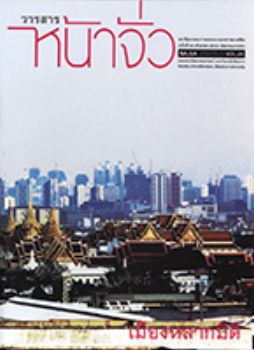ผลกระทบของระยะทางอาหารที่มีต่อรูปแบบอาณานิเวศของแหล่งอาหารของกรุงเทพมหานคร
Keywords:
ระยะทางอาหาร, อาณานิเวศ, รอยเท้านิเวศ, เกษตรกรรมในเมือง, food miles, ecological footprint, urban agricultureAbstract
“ระยะทางอาหาร” คือ “ระยะทางที่อาหารเดินทาง หรือถูกขนส่ง” โดยวัดตั้งแต่ระยะทางจากแหล่งผลิตอาหารจนถึงผู้บริโภค ใช้เป็นปัจจัยหนึ่งที่สำคัญในการประเมินผลกระทบจากการบริโภคและการใช้ชีวิตของ มนุษย์ต่อสภาพแวดล้อม ในการวิจัยนี้ ระยะทางอาหาร หมายถึง ระยะทางที่วัดจากพื้นที่เกษตรกรรม หรือ แหล่งผลิตจนถึงตลาดกลางการเกษตรชานเมืองกรุงเทพฯ โดยผู้บริโภค คือ ผู้ที่อาศัยอยู่ในกรุงเทพมหานคร การศึกษาผลกระทบของระยะทางอาหาร มีเป้าหมายเพื่อชี้ให้เห็นถึงความสำคัญของพื้นที่เกษตรกรรมในเมือง (Urban agriculture) ในการเป็นแหล่งผลิตอาหารที่สำคัญ โดยแสดงผลวิจัยออกมาในรูปของต้นทุนการขนส่งที่เป็นส่วนหนึ่งของค่าใช้จ่ายทางสิ่งแวดล้อม (Environmental cost) แผนที่แหล่งผลิตที่มาของอาหาร และแผนที่ระยะทางอาหาร การศึกษาเรื่องระยะทางอาหารที่มีผลต่อรูปแบบอาณานิเวศของแหล่งอาหารของกรุงเทพมหานคร โดยจะชี้ให้เห็นถึงความสำคัญและบทบาทของพื้นที่เกษตรกรรมในเมือง และแหล่งเพาะปลูกชานเมืองในการเป็นแหล่งผลิตอาหารที่สำคัญของกรุงเทพมหานคร รวมทั้งการสร้างจิตสำนึกของคนในเมืองเกี่ยวกับพฤติกรรมการบริโภคที่มีผลต่ออาณานิเวศ (Ecological footprint) ของกรุงเทพมหานคร
The Impacts of Food miles on the Pattern of Footprint of Bangkok’s Food supply
Kanokwalee Sueethorn
Department of Landscape Architecture, Faculty of Architecture Chulalongkorn University
Food mile is a distance foods travelled or imported from their production areas to consumers. Food miles concept is an important indicator to evaluate human impacts on the environment. In this research, food miles is the distance from different agricultural productive areas in Thailand to one of the largest wholesale market in Bangkok’s suburb which represent the ultimate consumers in Bangkok. The objective of the study is to signify the important roles of urban agriculture as an ecological productive landscape in the city by comparing different impacts from different food miles. The research examines the cost of transportation which is an important part of the environmental costs. Food production locations and food miles maps are illustrated to analyze the environmental cost of food from different locations. The study of Impacts of Food miles on the Pattern of Bangkok’s Footprint will emphasize the pivotal roles and the significances of ecosystem functions of urban agriculture. The research outcome will be a prominent evidence of environmental impacts which will create people awareness on their consuming behavior affected climate changes and ecological footprint of Bangkok.





